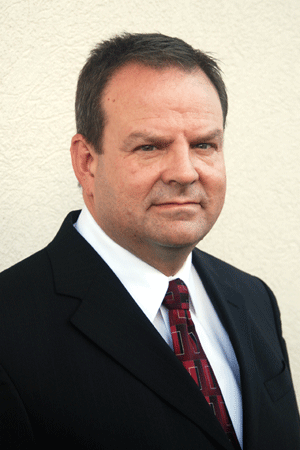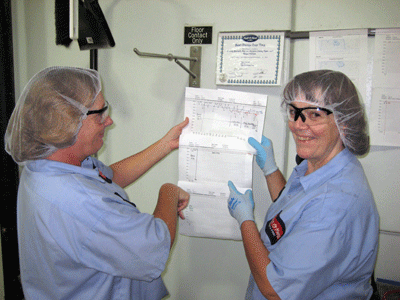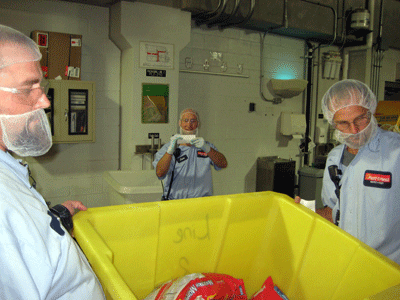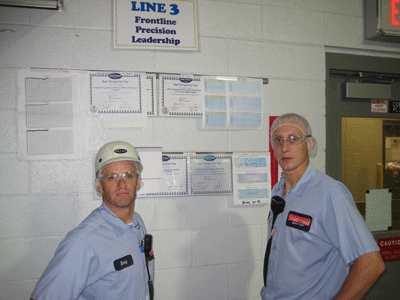A Culture of Safety Ownership at Malt-O-Meal
MOM Brands, headquartered in Minneapolis, Minnesota, began an American culinary tradition when it introduced its hot cereals in 1919. In 1965, the company manufactured its first ready-to-eat cereals and has since become the fastest growing cereal company in the country. Rapid growth—today MOM Brands operates six plants and eight distribution centers—hasn't compromised the company's dedication to product safety or to the safety of the employees who produce those products.
 In 2003, Mark Suchan joined MOM Brands as the plant manager of the company's first facility outside of Minnesota in Tremonton, Utah. “For MOM Brands it was quite a learning experience and I was given a lot of latitude in some of the things we tried as we started up the plant,” says Suchan. One of the first new things that Suchan tried was a behavior-based safety (BBS) effort. The company didn't have a behavior-based process in place, but Suchan was familiar with the concepts and attempted to get, what he describes, an “unstructured” process going. “It was really kind of a ragtag program,” he admits. “We didn't have all of the resources we needed to get it off the ground and to support it.”
In 2003, Mark Suchan joined MOM Brands as the plant manager of the company's first facility outside of Minnesota in Tremonton, Utah. “For MOM Brands it was quite a learning experience and I was given a lot of latitude in some of the things we tried as we started up the plant,” says Suchan. One of the first new things that Suchan tried was a behavior-based safety (BBS) effort. The company didn't have a behavior-based process in place, but Suchan was familiar with the concepts and attempted to get, what he describes, an “unstructured” process going. “It was really kind of a ragtag program,” he admits. “We didn't have all of the resources we needed to get it off the ground and to support it.”
But Suchan wasn't deterred. He met with Bob Johnston, the corporate director of safety. “Bob has been a big proponent of BBS." I said, "I'm just not getting the traction. We just don't seem to have the culture of safety. We talk about it and do some of the right things, but we don't see the results and we don't have real buy-in.” At this point the facility was experiencing an incident rate above industry average. According to Suchan, Johnston went on a quest to find a system that he felt would work. He found Aubrey Daniels International (ADI). “Its process appeared to match our company philosophy and seemed capable of taking us where we were trying to go. We wanted to ensure we had a program that could be applied against any system we were trying to improve. It needed to provide consistent reinforcement for the right behavior for any process we were trying to get to habit strength,” Suchan adds.
Feeding the Right Culture
MOM Brands wants to nurture a culture in which employees are accustomed to autonomy and the ability to make decisions. “We want our operators to feel ownership in our processes all the way through: quality, food safety, and personal safety,” Suchan explains. “We wanted them to have that ownership but some were just hesitant to take it on. We just weren't creating that culture of safety and personal ownership of safety.”
 When Bart Sevin, Ph.D., an ADI behavioral consultant, trained employees in peer-to-peer safety observations, neither they nor Suchan realized that it was the first key to creating a culture of team ownership. “At first we had to learn to approach each other and give each other feedback,” Suchan says, “That took a bit of learning.” That first step broke the ice and when employees learned that joining a safety team was voluntary, their participation began to grow. However, the management team faced a different type of challenge: they had to let go.
When Bart Sevin, Ph.D., an ADI behavioral consultant, trained employees in peer-to-peer safety observations, neither they nor Suchan realized that it was the first key to creating a culture of team ownership. “At first we had to learn to approach each other and give each other feedback,” Suchan says, “That took a bit of learning.” That first step broke the ice and when employees learned that joining a safety team was voluntary, their participation began to grow. However, the management team faced a different type of challenge: they had to let go.
“For the management team, the difficult part was getting out of the way,” says Suchan. Did the management need to micromanage the pinpoints the teams chose? Did they need to interfere with how the teams spent their celebration budgets? Was it necessary for management to determine which team members performed observations and when? For example, Suchan relates that early in the process management complicated matters by collecting all of the data and giving one person the role of compiling it into meaningful feedback. It just didn't work. The lesson learned: keep it simple and let the team members run the process!
"The temptation as managers is to say, 'Do it this way; spend your money that way; abide strictly by this rule.' It was tough for us not to do that, but once we really said that this was their program, let them define it, let them figure out how to run it, once we got over that hurdle, BBS took off and the flywheel was just spinning," Suchan says.
Team Ownership—the Safest Alternative
 After a year and a half, the Tremonton facility applies BBS at all levels of the organization with 25 safety teams consisting of anywhere from six to ten people, with two to three core team members from each group. Even though Suchan occasionally suggests a behavioral pin-point, the teams select their own pinpoints—up to three behaviors per safety checklist. They also collect data and chart their own progress for pinpoints such as washing hands using a defined process, wearing hair nets properly, donning gloves, or using ear plugs.
After a year and a half, the Tremonton facility applies BBS at all levels of the organization with 25 safety teams consisting of anywhere from six to ten people, with two to three core team members from each group. Even though Suchan occasionally suggests a behavioral pin-point, the teams select their own pinpoints—up to three behaviors per safety checklist. They also collect data and chart their own progress for pinpoints such as washing hands using a defined process, wearing hair nets properly, donning gloves, or using ear plugs.
With a goal of reaching habit strength for each behavior—defined as everyone doing the safe behavior all of the time—the teams repeatedly demonstrate that not only can they reach those goals, they understand the importance of admitting when they haven't. For example, team members may be more than halfway through to reaching a celebratory milestone when someone fails to complete a pinpointed behavior. Invariably the team reports the stall and starts again from the beginning. “We regularly compliment them on their integrity and encourage them to keep up the good work,” says Suchan.
Celebrating Success
“We do a lot of celebrating,” Suchan states. A lot of celebrating indicates a lot of success. Teams set their own subgoals and determine whether to spend their budgets on a series of small celebrations or on a larger reward once a behavior reaches habit strength. Often the team will celebrate subgoals with a purely social celebration or by bringing in small treats for the team and saving the budget bucks for a bigger event. Yet, they don't carry funds for longer than a month after reaching a goal in an effort to ad-here to the immediacy rule of reinforcement. Either way, the fact that they design their own reward is reinforcing in and of itself. “It's a big deal to give the teams control over the celebrations,” Suchan acknowledges. “They have a lot of fun with it and they come up with some pretty creative stuff. As for the process, it's got momentum now for sure.”
Sustaining Safety
 Part of that momentum depends on reinforcement from management. The management team makes a concerted effort to reinforce the process by going out on the floor and asking people how they are doing. Once a week they meet with the core team members who tell them about their pinpoints and share their progress.
Part of that momentum depends on reinforcement from management. The management team makes a concerted effort to reinforce the process by going out on the floor and asking people how they are doing. Once a week they meet with the core team members who tell them about their pinpoints and share their progress.
Sevin, the BBS consultant, arrives quarterly for “tune-up meetings” offering advice and tweaks to the ongoing safety efforts. At one time, only core team members were invited to these learning sessions but now that everybody is performing observations, the meetings are open to anyone who wishes to attend. Regular team meetings include discussions of safety topics, a quality topic, and any operational issues for the day.
The Right Mix
 The Tremonton facility made a good decision early on to designate three site champions—the operations line manager, the quality manager, and the safety manager. This combination has proved successful because it didn't burden any one person with too broad of a scope in such a large organization. “Their day jobs, if you will, are a natural fit,” Suchan explains. “We will always want to improve quality, we always want to improve food safety, and we can always improve on personal safety. We want to make sure that everyone goes home safe and those are issues that are easy to rally a team around. But we've also seen that we can use this approach whenever we have a new policy or procedure, a new way to measure ingredient yields, whatever the change may be; this is just a good way to implement change period.”
The Tremonton facility made a good decision early on to designate three site champions—the operations line manager, the quality manager, and the safety manager. This combination has proved successful because it didn't burden any one person with too broad of a scope in such a large organization. “Their day jobs, if you will, are a natural fit,” Suchan explains. “We will always want to improve quality, we always want to improve food safety, and we can always improve on personal safety. We want to make sure that everyone goes home safe and those are issues that are easy to rally a team around. But we've also seen that we can use this approach whenever we have a new policy or procedure, a new way to measure ingredient yields, whatever the change may be; this is just a good way to implement change period.”
In less than two years the employees at MOM Brand's Tremonton plant have learned that autonomy can extend to teams without limiting that of the individual. They've grown to enjoy the power they have to bring about positive change and the impact they have on achieving significant company goals not necessarily limited to safety. Suchan believes they have also achieved a culture of ownership for their own safety as well as that of their teammates. That is reason enough to celebrate and the fact that the plant has already reduced its incident rate by half is icing on the cake!


